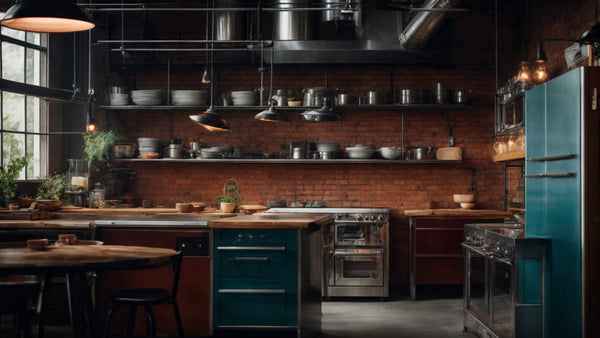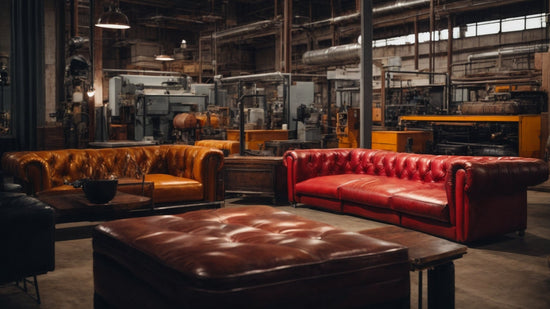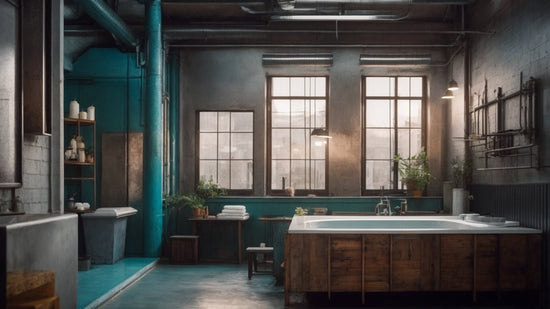Industrial Interior Design: Adding Urban Charm to Your Space
Table of content
1. Embracing Raw Materials
What are raw materials in industrial interior design?
- Exposed Brick: Leave brick walls unfinished to showcase their natural texture and character.
- Concrete: Use concrete floors, walls, or countertops for a modern industrial look.
- Steel: Incorporate steel beams, pipes, or furniture for a rugged and industrial vibe.
2. Exposed Structures
Why are exposed structures important in industrial design?
- Ceiling Beams: Leave ceiling beams or ductwork exposed to add architectural interest.
- Pipes: Display pipes and plumbing fixtures as decorative elements.
- Loft Spaces: Embrace the open concept and let structural elements shine.
3. Utilitarian Aesthetics
What characterizes the utilitarian aesthetics of industrial design?
- Minimalism: Keep furnishings and decor simple and functional.
- Unfinished Look: Embrace imperfections and celebrate the beauty of industrial materials.
- Repurposed Items: Use salvaged or repurposed items for a unique and eclectic feel.
4. Neutral Color Palette
What colors are commonly used in industrial interior design?
- Earthy Tones: Opt for shades of gray, brown, and black to complement industrial materials.
- Monochromatic Scheme: Stick to a single color or vary shades within the same color family.
- Pop of Color: Add visual interest with vibrant accents like red, yellow, or turquoise.
5. Functional Furniture
What types of furniture are suitable for industrial spaces?
- Reclaimed Wood: Choose tables, shelves, and seating made from reclaimed or distressed wood.
- Metallic Finishes: Opt for furniture with metal frames or accents for an industrial edge.
- Industrial Shelving: Use open shelving units or wire racks for storage and display.
6. Statement Lighting
How can lighting enhance the industrial aesthetic?
- Exposed Bulbs: Install pendant lights or chandeliers with exposed bulbs for an industrial look.
- Edison Bulbs: Choose vintage-style Edison bulbs for a warm and nostalgic ambiance.
- Industrial Fixtures: Opt for fixtures made from metal, glass, or wire for an industrial touch.
7. Vintage Accents
How can vintage accents complement industrial design?
- Antique Finds: Incorporate vintage signage, machinery, or decor items for a sense of history.
- Distressed Finishes: Choose furniture or accessories with distressed finishes for a weathered look.
- Retro Accessories: Add mid-century modern or retro accessories for a playful contrast.
8. Urban Artwork
What types of artwork complement industrial interiors?
- Industrial Photography: Display black-and-white photographs of urban landscapes or industrial scenes.
- Graffiti Art: Add edgy street art or graffiti murals for a modern urban vibe.
- Metal Sculptures: Incorporate metal sculptures or wall art inspired by industrial materials.
9. Open Floor Plans
Why are open floor plans popular in industrial design?
- Space Efficiency: Maximize space and flexibility by eliminating walls and partitions.
- Visual Continuity: Create a seamless flow between living, dining, and kitchen areas.
- Industrial Aesthetic: Showcase exposed structural elements and industrial materials.
10. Urban Greenery
How can plants enhance an industrial interior?
- Indoor Plants: Add greenery with low-maintenance plants like succulents or air plants.
- Vertical Gardens: Install vertical gardens or hanging planters to maximize space.
- Industrial Planters: Use metal or concrete planters for an urban and industrial look.
11. Functional Storage Solutions
How can you incorporate storage into industrial interiors?
- Industrial Shelving Units: Install open shelving units made from metal pipes and reclaimed wood.
- Wire Baskets: Use wire baskets or crates for storing blankets, magazines, or firewood.
- Hidden Storage: Opt for furniture with built-in storage compartments or hidden drawers.
12. Minimalist Accessories
What types of accessories complement industrial design?
- Metallic Accents: Add touches of metal with decor items like candle holders or trays.
- Industrial Clocks: Display oversized or vintage-style clocks for a functional and decorative touch.
- Weathered Mirrors: Hang distressed mirrors to reflect light and add visual interest.
13. Comfortable Textiles
How can textiles soften the industrial aesthetic?
- Cozy Throws: Drape soft throws or blankets over sofas or chairs for added comfort.
- Plush Rugs: Layer plush rugs over concrete or hardwood floors to add warmth and texture.
- Patterned Pillows: Add throw pillows with bold patterns or textures for visual interest.
14. Industrial Kitchen Design
What are key features of an industrial-style kitchen?
- Stainless Steel Appliances: Choose stainless steel appliances for a sleek and modern look.
- Concrete Countertops: Install concrete countertops for a durable and industrial aesthetic.
- Open Shelving: Use open shelving to display dishes, glassware, and kitchen essentials.
15. Industrial Bathroom Design
How can you create an industrial-style bathroom?
- Exposed Pipes: Leave plumbing fixtures exposed for an industrial and utilitarian look.
- Concrete Accents: Incorporate concrete sinks, countertops, or floors for an industrial vibe.
- Edgy Lighting: Install industrial-style sconces or pendant lights for a modern touch.
16. Industrial Bedroom Design
What are key elements of an industrial-style bedroom?
- Platform Bed: Choose a platform bed with a metal frame or reclaimed wood for an industrial look.
- Exposed Brick: Expose brick walls or use faux brick wallpaper for an urban loft feel.
- Urban Art: Display graffiti art or industrial photography for a contemporary vibe.
17. Industrial Office Design
How can you create an industrial-style office?
- Steel Desks: Choose steel desks or industrial-style tables for a modern and utilitarian workspace.
- Exposed Ceiling: Leave the ceiling unfinished or expose ductwork for an industrial aesthetic.
- Vintage Accessories: Incorporate vintage typewriters, telephones, or signage for a nostalgic touch.
18. Urban Loft Design
What defines an urban loft design?
- Open Layout: Embrace an open floor plan with high ceilings and expansive windows.
- Industrial Materials: Use raw materials like brick, concrete, and steel for an urban loft vibe.
- Flexible Spaces: Create multifunctional areas that adapt to various activities and needs.
19. Warehouse Conversion Design
How can you transform a warehouse into a livable space?
- Exposed Beams: Highlight original architectural features like exposed beams or trusses.
- Open Concept: Maintain an open layout to preserve the industrial character of the space.
- Modern Amenities: Update the interior with modern amenities while preserving industrial charm.
20. Urban Chic Design
What defines urban chic design?
- Eclectic Mix: Combine industrial elements with vintage, modern, or bohemian accents.
- Artistic Flair: Showcase artwork, sculptures, or textiles that reflect urban culture and creativity.
- Functional Design: Prioritize functionality and comfort without sacrificing style and sophistication.
21. Loft Living Design
What are key features of loft living design?
- High Ceilings: Enjoy spacious interiors with high ceilings that create an airy and open feel.
- Large Windows: Maximize natural light and city views with expansive windows or glass walls.
- Flexible Layouts: Customize your space to suit your lifestyle with versatile furniture and zoning techniques.
22. Industrial Revival Design
What characterizes the industrial revival design trend?
- Historic Preservation: Restore and repurpose historic buildings or factories for modern living.
- Modern Updates: Incorporate contemporary amenities and design elements while preserving heritage features.
- Community Engagement: Foster a sense of community and revitalization through adaptive reuse projects.
What are raw materials in industrial interior design?
- Exposed Brick: Leave brick walls unfinished to showcase their natural texture and character.
- Concrete: Use concrete floors, walls, or countertops for a modern industrial look.
- Steel: Incorporate steel beams, pipes, or furniture for a rugged and industrial vibe.
Why are exposed structures important in industrial design?
- Ceiling Beams: Leave ceiling beams or ductwork exposed to add architectural interest.
- Pipes: Display pipes and plumbing fixtures as decorative elements.
- Loft Spaces: Embrace the open concept and let structural elements shine.
What characterizes the utilitarian aesthetics of industrial design?
- Minimalism: Keep furnishings and decor simple and functional.
- Unfinished Look: Embrace imperfections and celebrate the beauty of industrial materials.
- Repurposed Items: Use salvaged or repurposed items for a unique and eclectic feel.
What colors are commonly used in industrial interior design?
- Earthy Tones: Opt for shades of gray, brown, and black to complement industrial materials.
- Monochromatic Scheme: Stick to a single color or vary shades within the same color family.
- Pop of Color: Add visual interest with vibrant accents like red, yellow, or turquoise.
What types of furniture are suitable for industrial spaces?
- Reclaimed Wood: Choose tables, shelves, and seating made from reclaimed or distressed wood.
- Metallic Finishes: Opt for furniture with metal frames or accents for an industrial edge.
- Industrial Shelving: Use open shelving units or wire racks for storage and display.
How can lighting enhance the industrial aesthetic?
- Exposed Bulbs: Install pendant lights or chandeliers with exposed bulbs for an industrial look.
- Edison Bulbs: Choose vintage-style Edison bulbs for a warm and nostalgic ambiance.
- Industrial Fixtures: Opt for fixtures made from metal, glass, or wire for an industrial touch.
How can vintage accents complement industrial design?
- Antique Finds: Incorporate vintage signage, machinery, or decor items for a sense of history.
- Distressed Finishes: Choose furniture or accessories with distressed finishes for a weathered look.
- Retro Accessories: Add mid-century modern or retro accessories for a playful contrast.
What types of artwork complement industrial interiors?
- Industrial Photography: Display black-and-white photographs of urban landscapes or industrial scenes.
- Graffiti Art: Add edgy street art or graffiti murals for a modern urban vibe.
- Metal Sculptures: Incorporate metal sculptures or wall art inspired by industrial materials.
Why are open floor plans popular in industrial design?
- Space Efficiency: Maximize space and flexibility by eliminating walls and partitions.
- Visual Continuity: Create a seamless flow between living, dining, and kitchen areas.
- Industrial Aesthetic: Showcase exposed structural elements and industrial materials.
How can plants enhance an industrial interior?
- Indoor Plants: Add greenery with low-maintenance plants like succulents or air plants.
- Vertical Gardens: Install vertical gardens or hanging planters to maximize space.
- Industrial Planters: Use metal or concrete planters for an urban and industrial look.
How can you incorporate storage into industrial interiors?
- Industrial Shelving Units: Install open shelving units made from metal pipes and reclaimed wood.
- Wire Baskets: Use wire baskets or crates for storing blankets, magazines, or firewood.
- Hidden Storage: Opt for furniture with built-in storage compartments or hidden drawers.
What types of accessories complement industrial design?
- Metallic Accents: Add touches of metal with decor items like candle holders or trays.
- Industrial Clocks: Display oversized or vintage-style clocks for a functional and decorative touch.
- Weathered Mirrors: Hang distressed mirrors to reflect light and add visual interest.
How can textiles soften the industrial aesthetic?
- Cozy Throws: Drape soft throws or blankets over sofas or chairs for added comfort.
- Plush Rugs: Layer plush rugs over concrete or hardwood floors to add warmth and texture.
- Patterned Pillows: Add throw pillows with bold patterns or textures for visual interest.
What are key features of an industrial-style kitchen?
- Stainless Steel Appliances: Choose stainless steel appliances for a sleek and modern look.
- Concrete Countertops: Install concrete countertops for a durable and industrial aesthetic.
- Open Shelving: Use open shelving to display dishes, glassware, and kitchen essentials.
How can you create an industrial-style bathroom?
- Exposed Pipes: Leave plumbing fixtures exposed for an industrial and utilitarian look.
- Concrete Accents: Incorporate concrete sinks, countertops, or floors for an industrial vibe.
- Edgy Lighting: Install industrial-style sconces or pendant lights for a modern touch.
What are key elements of an industrial-style bedroom?
- Platform Bed: Choose a platform bed with a metal frame or reclaimed wood for an industrial look.
- Exposed Brick: Expose brick walls or use faux brick wallpaper for an urban loft feel.
- Urban Art: Display graffiti art or industrial photography for a contemporary vibe.
How can you create an industrial-style office?
- Steel Desks: Choose steel desks or industrial-style tables for a modern and utilitarian workspace.
- Exposed Ceiling: Leave the ceiling unfinished or expose ductwork for an industrial aesthetic.
- Vintage Accessories: Incorporate vintage typewriters, telephones, or signage for a nostalgic touch.
What defines an urban loft design?
- Open Layout: Embrace an open floor plan with high ceilings and expansive windows.
- Industrial Materials: Use raw materials like brick, concrete, and steel for an urban loft vibe.
- Flexible Spaces: Create multifunctional areas that adapt to various activities and needs.



